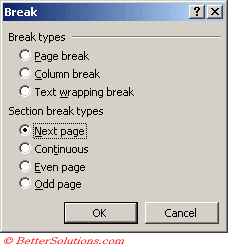Section Breaks
You can use sections to vary the layout of a document within a page or between pages.
Section formatted as a single column
Section formatted as two columns
Just insert section breaks to divide the document into sections, and then format each section the way you want.
For example, format a section as a single column for the introduction of a report, and then format the following section as two columns for the report's body text.
Types of Section breaks
You can create a new section at any time by selecting (Insert > Break) and choosing the approriate break
There are four types of section breaks:
 |
Next Page - Inserts a section break and breaks the page so that the next section starts at the top of the next page.
Continuous - Inserts a section break and starts the new section immediately, without inserting a page break.
Odd Page - Word begins the new section on the next odd-numbered page. This section break is often used for chapters that begin on odd-numbered pages. NOTE: If the section break falls on an odd-numbered page, Word leaves the intervening even-numbered page blank.
Even Page - Similar to Odd Page, but Word begins the new section on the next even-numbered page.
Page break -
Column break -
Text wrapping break -
Keep in mind that a section break controls the section formatting of the text that precedes it.
For example, if you delete a section break, the preceding text becomes part of the following section and assumes its section formatting.
Note that the last paragraph mark in the document controls the section formatting of the last section in the document - or of the entire document if it doesn't contain sections.
Changing
This can be done by
The best way to change a section break is *not* to try to delete it or replace it. Instead, place the insertion point in the section following the break, go to the Layout tab of Page Setup, and change the "Section start" to "Continuous."
You must remember that the formatting for each section is maintained in the section breaks at the end of each section. This might seem odd, since you can only see two section breaks in the document, even though there are three sections.
The formatting for Section 1 (New Page) is in the first section break.
The formatting for Section 2 (Continuous) is in the second section break.
The formatting for Section 3 (New Page) is in the implied section break that is always at the end of a document.
Note that there is an implied section break at the end of the document. This section break is not visible, of course, but it is nonetheless there, and contains formatting for the final section.
When you position your insertion point just before the second section break and press the Delete key, the section break is deleted. This deletes the section formatting for the second section, and the text in that section automatically is formatted according to what was in the third section.
There really is no way to delete the final section (the implied section that is always there) in a document. Instead, you must change the formatting of that section so it reflects what you want.
http://wordtips.vitalnews.com/Pages/T0262_Avoiding_a_Section_Break_Booby_Trap.html
http://etd.circa.ufl.edu/present/sectionbreaks.html
http://word.mvps.org/FAQs/Formatting/FtnoteSpanColumns.htm
If this doesn't work, try copying the text from each section (separately, without the section break) to a new document, then reinserting the section breaks as needed.
© 2025 Better Solutions Limited. All Rights Reserved. © 2025 Better Solutions Limited TopPrevNext